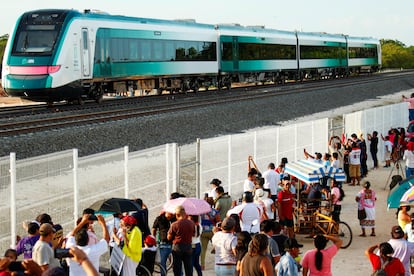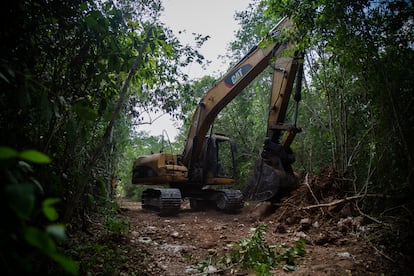Still under construction, more expensive tickets: This is how Mexico’s Maya Train is getting started
President López Obrador travels to Campeche for the inauguration of his administration’s flagship project, which has been dogged by criticism due to cost overruns and its social and environmental impact

On the official website of the Maya Train, a countdown marks only a couple of hours until the start of what is already considered the flagship infrastructure project of the government of President Andrés Manuel López Obrador. The beginning of operations will be partial and only along the first completed segment of tracks, from Campeche to the city of Cancún, in the state of Quintana Roo. In addition, the train tickets are priced within a range of 1,166 to 1,862 Mexican pesos ($68 to $108), a different set of rates from what was initially proposed, with Mexican citizens slated to pay about 60 pesos (about four dollars). And it’s not only the fare that has ballooned: cost overruns for the infrastructure are nearly three times over budget, according to estimates. The project, which has been funded entirely with public money, comes with a price tag of nearly 500 billion pesos ($29 billion).
The president on Thursday traveled down to the spot where he was scheduled to inaugurate a mega-project that is still dogged by disputes over the natural areas that the railway crosses and the effects that the construction work has had on the environment and the territorial dynamics of several surrounding communities.
With the inauguration, López Obrador will also begin to navigate the last months of his administration, fulfilling the pledge he made in 2018 when he asserted that the Maya Train would connect “one of the most culturally important regions in the world.”
The inaugural trip that the president will make in the early hours of Friday will begin in San Francisco de Campeche and will continue to Mérida, Yucatán, to end in Cancún, according to General Óscar David Lozano, the official in charge of the work. On Saturday the first passengers will begin their journey at 7:00 a.m. and there will be a second train departing from both points on that route — Campeche and Cancún — at 11:00 a.m. On January 15, a third train will be added to complete three schedules: 7:00 a.m., 9:00 a.m. and 11:00 a.m. And on January 31, the route from Palenque to Cancún will be operating with the same schedule. “The inauguration of the entire rail transportation system will not take place until February 29,” said Lozano. The convoy that was used in preliminary security tests is of a standard type and has capacity for 230 passengers.

There are 14 stations on the first route, representing 473 kilometers along three states: Campeche, Yucatán and Quintana Roo, out of a project that includes more than 1,500 kilometers. Those 14 stations out of 34 will initially open to the public, but on Friday not everything was ready; in Chichén Itza and Cancún the roof stage had only just begun. The plan is for sections 5, 6 and 7 of the system to be inaugurated at the end of February 2024.
Resistance to the megaproject
There are hundreds of civil society groups bringing together activists, citizens, academics and artists, such as Sélvame del Tren, Selva Maya SOS, La Selva Salva, Voces Unidas Puerto Morelos, Voto por el Clima, The Mexican Center for Environmental Law (CEMDA), or the global campaign El Sur Resiste, which remain in open opposition to the train. More than 25 appeals have been filed by these organizations and by citizens who report an ecocide and an attitude of indifference about the impact of a tourism-oriented project that has begun to transform not only the landscape but the social dynamics of the surrounding communities.
Just a couple of days earlier, one of those organizations, El Sur Resiste (The South Resists), sent President López Obrador and the public the following questions: “We the people ask ourselves: What are you going to inaugurate? The deforestation of the peninsula? The destruction of the cenotes? The destruction of cultures? The increase in femicides, disappearances, crime and insecurity?” they published in a statement on Wednesday.

Groups of searching mothers in Cancún, for example, have reported for a couple of months an increase in the rate of missing people in areas where railway construction workers have come down to find jobs from other states such as Tabasco, Veracruz and the State of Mexico.
In addition, activists and organizations have denounced the militarization of the areas near the train sections, in the hands of the Ministry of Defense. One example is the recently inaugurated Tulum military airport, located in the municipality of Felipe Carrillo Puerto and built on a budget of 3.2 billion pesos ($192 million), which according to activists “is functioning as a military base.”
Sign up for our weekly newsletter to get more English-language news coverage from EL PAÍS USA Edition
Tu suscripción se está usando en otro dispositivo
¿Quieres añadir otro usuario a tu suscripción?
Si continúas leyendo en este dispositivo, no se podrá leer en el otro.
FlechaTu suscripción se está usando en otro dispositivo y solo puedes acceder a EL PAÍS desde un dispositivo a la vez.
Si quieres compartir tu cuenta, cambia tu suscripción a la modalidad Premium, así podrás añadir otro usuario. Cada uno accederá con su propia cuenta de email, lo que os permitirá personalizar vuestra experiencia en EL PAÍS.
¿Tienes una suscripción de empresa? Accede aquí para contratar más cuentas.
En el caso de no saber quién está usando tu cuenta, te recomendamos cambiar tu contraseña aquí.
Si decides continuar compartiendo tu cuenta, este mensaje se mostrará en tu dispositivo y en el de la otra persona que está usando tu cuenta de forma indefinida, afectando a tu experiencia de lectura. Puedes consultar aquí los términos y condiciones de la suscripción digital.











































